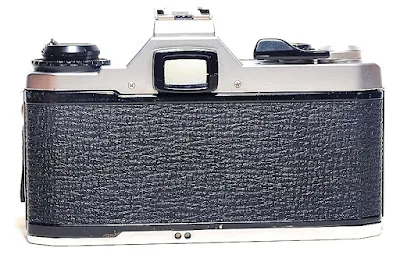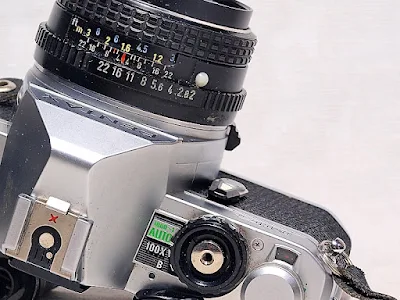The Pentax MG, introduced by Pentax in 1981 as an update to the Pentax MV, and MV1 (1979-82), is an entry-level aperture-priority manual focus AE (Auto Exposure) 35mm SLR film camera. Much like features found on other entry-level 35mm SLR film cameras of the era, the Canon AV-1, Nikon EM, and Praktica B100 Electronic to name a few, the camera has no manual setting for shutter speed selection, which is set automatically by the camera when the camera shutter is released.
The camera is fitted with a vertical travel metal focal plane shutter, electronically controlled from 1 to 1/1000 second, accepts film with an ISO speed range from 25 to 1600, and a shutter speed control that has only three options - Auto, 100X (1/100, X sync), and B. The 100X and B options can be used to operate the shutter when the battery on the camera is depleted or dead.
Metering is open aperture center-weighted TTL, the camera is also fitted with a 4 to 10-second delay push-activated mechanical self-timer, a hot shoe with an additional contact for dedicated Pentax flash units, and uses 2 x SR/LR-44 batteries or equivalent to power the metering and electronic shutter functions.
The body design of the Pentax MG is compliant with the M-Family series (ME, MX, MV, etc.) and is compatible with the external Winder ME (1.5 frame/s) or the later Winder ME II (2 frame/s). The Pentax MG could use the Dial Data ME databack with an adaptor to slide in the hot shoe or directly use the Digital Data M databack. The camera is compatible and can be used with all Pentax K-mount lenses.
The Pentax MG, available in chrome or black finish, stayed in production until 1985.
Basic Camera Features
A simple front, with only the lens mount housing with the lens release button on the lower-left of the vertical, and the self-timer mechanism halfway up the body just on the left of the mount.
The film rewind crank is integrated with the film back pull-up latch lock and pull-up and turn film ASA selection dial on the left end of the top plane. The hot shoe is on the apex of the pentaprism, and to the right of the top plane, the shutter release and shutter mode dial cluster, the film forward lever crank, and the frame counter window.
The backplane is plain and sparse, with only the hinged interchangeable film back, and the viewfinder eyepiece at the back of the pentaprism hump.
On the bottom plane, from the left are the film autowinder coupler, film rewind release button, tripod socket, battery chamber, and electrical contacts for the winder.
The film box is the standard quick load configuration as found on other 35mm Pentax SLR film cameras of that era, with the film canister chamber, shutter window, film sprocket gear, and the multi-pin film pickup spool laid from left to right.
Film Loading and Rewind
To load film into the camera, first, set the shutter speed dial to 100X, or if the speed setting is set to Auto, take the lens cap off the camera. Next, open the film back, drop in the film canister into the chamber (located on the left of the film box), pull the film tab across over the shutter window area, and insert the film end into a slot on the multipin take-up spool.
Ensure that the film is firmly aligned (with no slack) across the film box, close the film back, crank the film forward, and do the 2-blank shot sequence to bring the unexposed part of the film to Frame 1. Reset the shutter speed dial to Auto and you are ready to go.
To rewind the film at the end of the film roll, first, fold out the film rewind crank handle from its rest position, press the film rewind release button located on the bottom plane of the camera, and crank the rewind lever in the clockwise direction until the film is fully wound back into the film canister.
Viewfinder Readout
The viewfinder of the Pentax MG is a pentaprism finder, with a centrally located split/image microprism focusing screen with a 92% image field display, and a two-third height shutter speed tab with LED diode indicators located on the left of the screen.
The diode display is Red (at the top and bottom of the bar) for over- and underexposure, Green (the middle portion) for adequate hand-held shooting with automatic shutter speed selection from 1/000 down to 1/60 seconds, and Orange (for shutter speeds below 1/30 second) for the slower speeds for which the camera is recommended to be placed on a tripod or to be used with a flash unit.
Aperture Priority Shooting
Aperture priority shooting is normally a two-handed operation, with the right hand holding the camera and the index finger on the shutter release button, half-pressed to activate the metering system, while the thumb and index finger of the left hand are used for both focusing and adjusting the lens aperture opening.
Use the focus ring to frame and focus the image, next, adjust the lens aperture opening to the shutter speed you want to capture the image with and release the shutter. Simple enough, even for a beginner.
Exposure Compensation
A very neat feature of the Pentax MG is the exposure compensation dial which is located under the pull-up film rewind crank. To use, first, pull up the film rewind crank (careful not to pull it all the way as this may release the film back latch), and use your finger to line up the externally visible red dot of the dial to the ASA speed setting of the film roll you have in the camera, push back the film rewind crank to its down position.
Once this feature is set, you can use the ASA speed dial (pull-up and turn) to set the following exposure compensation. Do this by halving or doubling the ASA speed setting for 1/4x steps compensation.
Self-Timer
The self-timer on the Pentax MG is a self-activated system. This is done by first turning the self-timer lever anti-clockwise to the estimated delay duration (from 4 to 10 seconds) and activating by a slight pushup of the lever itself. Make sure that the film has been forwarded to a new frame before executing.
Multiple Exposures
Multiple exposures on the Pentax MG are done by first pressing the film rewind button and cranking the film forward crank fully. To effect this sequence, the film must first be tensioned properly. Do this by rewinding the film back slightly until it is fully tensioned.
Time Exposure
The best option for timed exposures, or extended exposure in low-light conditions, is to set the camera on a stand, or on a firm surface and the shutter release activated via a lockable shutter release cable. This will reduce or eliminate the chances of contact vibration or physical movement.
Updates Over the MV and MV1
Where the body shape and design are almost identical, when compared to the MV and MV1, the MG is fitted with a slightly different light meter and viewfinder, fitted with a shutter-speed display, and lighted diodes for the selected options.
The MV is not fitted with a self-timer, the MV1, while the MG has one, a self-activated mechanical contraption.
In Use
The Pentax MG, with its small, compact, and rather lightweight body, should be fun and easy to use. The camera is easy enough for the beginner use to get used to and be comfortable with while having the added advantage of easy access to optionally a wide and varied range of Pentax and OEM interchangeable PK-mount lenses that are easily available on the market.
Using the camera with the standard 50mm F2 kit lens in backlighted scenes or for outdoor portrait photography is convenient with the ability to set exposure compensation enough with film ISO speed dial.
On the other hand, one can always opt for the pancake SMC Pentax-M 40mm F2.8 lens for a really compact and almost pocketable setup or go for snapshot point-and-shoot sessions with the camera on high-speed film, a wide-angle lens, and hyperfocal distance setting...
Battery and Camera Body Weight
The Pentax MG requires a pair of LR44 or SR44 button cells to operate the metering system and shutter speed control. When the battery is depleted the camera will default to a shutter speed of 1/100 second.
The camera's body weight is 423 grams without batteries.
Instruction Manual
You are free to download the Pentax MG PDF manual from buktus.org.























No comments:
Post a Comment